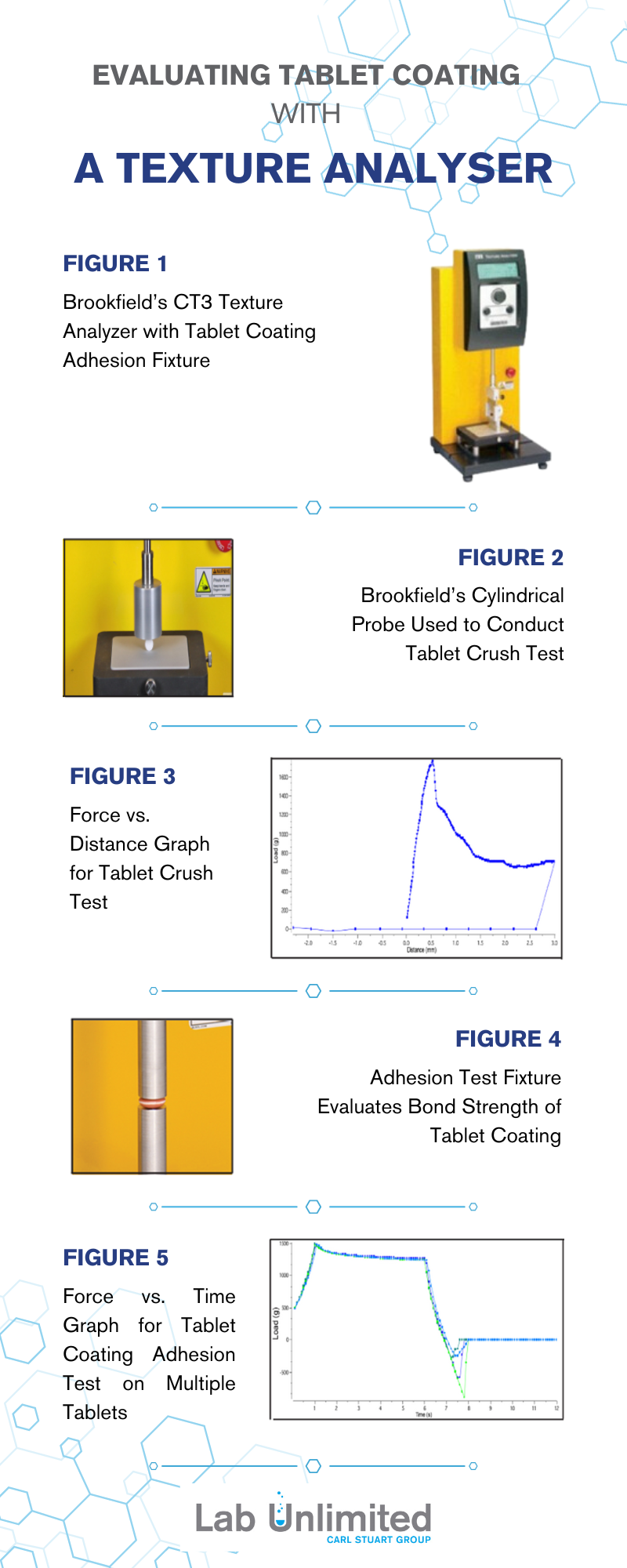
Evaluating Tablet Coating with a Texture Analyser
Texture analysis is a vital tool in maintaining uniformity in tablet design, enhancing textural characteristics, safeguarding tablet integrity throughout the manufacturing and transportation phases, and comprehending the consumer/patient experience during oral consumption, whether it's swallowing or chewing. The versatility of CT3 Texture Analysers in research and development (R&D) laboratories is exemplified by their ability to provide precise measurements of the physical properties of tablets, aligning seamlessly with these prerequisites (as illustrated in Figure 1). Quality Control (QC) subsequently integrates simplified "texture" tests to confirm that tablet production adheres to R&D's stringent criteria. The contemporary advantage of texture instruments lies in their adaptability, enabling them to operate under PC control for advanced R&D testing, while also offering rapid single-point tests for standalone QC operations, eliminating the need for computer intervention.
Crushing Test for Tablet Strength
Tablets, integral to pharmaceutical practices for their user-friendly administration, compactness, and manufacturing convenience, present an intricate challenge to research and development (R&D) efforts. Crafting a tablet capable of withstanding diverse processing sequences, including the rigorous spinning within a hopper, while ensuring precise and controlled drug release in the body, is a formidable task. Furthermore, these tablets must exhibit the robustness to endure the trials of packaging, storage, shipping, and handling by both pharmacists and patients. Thus, it becomes imperative to thoroughly evaluate the tablet's integrity throughout its journey from production to distribution. Employing a CT3 Texture Analysers in compression mode, we can precisely determine the force required to induce tablet failure, employing a 'crushing test' (see Figure 2).
For this test, a cylinder probe with an appropriate diameter (as depicted in Figure 2) is selected, with a diameter notably exceeding that of the tablet. The probe descends onto the tablet at a relatively slow pace, around 0.1mm/sec. The penetration distance for the probe is set at approximately half of the tablet's thickness. Experimentation confirms the effectiveness of these testing parameters, with the load force values obtained during the crushing tests hinging on the tablet's construction and dimensions. Should the measurement range of the texture analyser permit, the consideration of faster testing speeds becomes viable.
Figure 3 illustrates a typical plot, portraying the relationship between force load (measured in grams) and penetration distance (in millimetres) as the crushing test progresses for an individual tablet. Remarkably, the peak force in this instance surpasses 1600 grams. Subsequent tests conducted on multiple tablets from the same batch culminated in the determination of a mean value of 1645 grams, accompanied by a standard deviation of +/- 31 grams. With the aid of software for the Texture Analyser, this calculation is performed automatically, streamlining the evaluation process.
Assessing Coating Adhesion on Tablets
Tablet coatings serve as a shield against moisture, enhance taste, facilitate swallowing, regulate drug release, and simplify handling and packaging. The strength of the bond between the coating and the tablet's surface, as well as the internal stresses within the coating, significantly impact the quality of this adhesion. Insufficient adhesion can lead to peeling, diminishing the functionality of the protective film. Additionally, compromised adhesion may jeopardise the coating's mechanical protection, potentially resulting in the accumulation of moisture at the interface between the film and the tablet, ultimately affecting the stability of the enclosed medication. Numerous variables, such as tablet composition, compression force, surface roughness, coating formulation, and application conditions, influence the adhesion process.
To effectively quantify the adhesive strength of the coating on the tablet's surface accommodate variations in coating formulations and ensure tablet integrity, the CT3 Texture Analysers proves to be an invaluable tool. Figure 4 illustrates the Adhesion Fixture, consisting of two cylinders with contoured surfaces designed to securely sandwich the slightly oval-shaped tablet. The tablet is firmly held in place between the cylinders using double-sided adhesive tape. The Texture Analyser initially operates in compression mode, firmly establishing a bond between the tablet and the cylinders. Subsequently, the cylinders are pulled apart in tension mode, progressing at a consistent rate of 1.0mm/sec. This action leads to the adhesion of the tablet's coating to the adhesive tape, which subsequently peels away from the tablet's body.
Figure 5 showcases typical plots, depicting the relationship between force load (measured in grams) and time as the cylinders come together, followed by the separation during tests conducted on four distinct tablets. During the compression cycle, the peak load surpasses 1500 grams, indicating the tablets' bonding with the taped cylinder ends. The ensuing tension cycle reveals the maximum force required to detach the coating from the tablet's surface, varying from 250 grams to 700 grams.
Quality Control (QC) now has the capability to perform statistical evaluations on adhesion tests for tablets produced in different batches. These evaluations will record the peak force during the compression cycle and the maximum adhesive force during the tension cycle. The software integrated with the Texture Analyser automatically calculates mean values and standard deviations, streamlining the assessment process.
For further insights and visual guidance, we encourage you to explore the Brookfield CT3 Instructional Video: Tablet Coating.
In Summary
Incorporating the Crush Test and Coating Adhesion Test into tablet manufacturing processes enables consistent production of high-quality products that meet consumer expectations. The time required to perform these tests is insignificant compared to the potential customer service time needed to address complaints about tablet integrity. Moreover, the investment in equipment for these tests is well below €10,000, and the training time required to set up and run the tests is likely no more than an hour. Therefore, it is worth considering how Texture Analysers can enhance Quality Control in tablet manufacturing, ultimately improving the bottom line.
Discover how Texture Analysers can enhance your Quality Control in tablet manufacturing. Learn more about our Texture Analysers at Lab Unlimited.
|
To Find Out More: |

